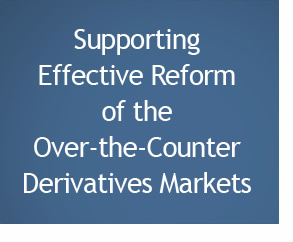03/10/10 - Bloomberg - By Karen Brettell
|
|
ICE, CME clearing membership rules challenged for CDS
NEW YORK, March 10 (Reuters) - The membership rules for the divisions of the IntercontinentalExchange Inc (ICE.N) and the CME Group (CME.O) that will clear credit default swaps are being challenged by firms who say the exchanges' requirements may limit participation to established dealers.
ICE and CME are the only clearinghouses in the U.S. that have begun clearing trades in the $31 trillion CDS market, but participation by "buyside" firms has been slow due to concerns about the protection of collateral backing the trades.
Central clearing of derivatives is touted as a key component of U.S. financial regulation reform as the clearing house stands between trade counterparties and guarantees the contracts, reducing the risk of losses if another bank were to fail like Lehman Brothers did in 2008.
Some managers and regulators are concerned though that the membership of the two clearing arms is limited to the same dealers that dominate CDS trading, and that stress on Merrill Lynch and others after the Lehman bankruptcy showed that dealer failures can be highly correlated.
Potential new members are being discouraged by capital requirements which limit membership to only the largest firms, critics said. A rule that clearing members provide their own pricing for CDS contracts also effectively restricts membership to large CDS dealers.
"Right now most of the regulations would preclude anybody that did not clear and deal three years ago from entering and having access to clearing and dealing now," said Brian Yelvington, analyst at Knight Libertas in Greenwich, Connecticut.
A number of brokers active in equity and other fixed income markets, and clearing agents established in other markets, are seeking to offer clearing services for derivatives, including credit default swaps and interest rate swaps.
For example, one of the world's largest brokers, Newedge, backed by Credit Agricole CIB and Societe Generale, said on Wednesday it plans to offer interest rate derivative clearing services through the International Derivatives Clearinghouse.
A new association, the Swaps and Derivatives Market Association (SDMA), is also pushing for changes to open clearing to more participants.
"There's a constant need for alternative providers of liquidity and market intelligence," said Mike Hisler, a partner at investment bank Hexagon Securities, and member of the SDMA. "More liquidity will lower transaction costs, increase transparency and protect customer anonymity."
SDMA initially comprises more than 20 brokers and fund managers, and is expanding to new members.
ICE spokeswoman Kelly Loeffler said CDS clearing is still in its beginning stages, adding that the clearinghouse is continuing to develop "flexible, innovative programs for the buyside that are responsive to their needs within a highly regulated environment."
CME spokesman Michael Shore said the CME's model was designed in conjunction with interested potential clearing members and the company's risk committee, "with a focus on providing maximum client protection."
Eligibility criteria for clearing over-the-counter derivatives is also different from the criteria for futures contracts and options, "due to the different nature of the asset class," he added.
OTC DIFFERENCE?
The SDMA wants clearing models for over-the-counter derivatives to function in a way that is similar to futures markets, where trades can be routed to central clearing members by a wide range of brokers or other participants.
At present, CDS contracts can only be put into the ICE and CME clearinghouses by dealers, who enter the trades through approximately 10 clearing members, who are also dealers.
CDS dealers say that stringent membership requirements need to be placed on clearing members because each firm would be required to take on positions from a failed party, which could involve moving billions of dollars within hours.
The ability to price the contracts is also needed, they say, because clearing members need to be able to gauge on their own the risks of the contracts they guarantee, which typically have longer trade horizons than futures markets.
The SDMA argues that the more clearing members in a clearing structure, the more liquidity available to take on positions in the event of a clearing member failure. Different tiers of membership could also be structured to account for different firm sizes and risk profiles.
Some regulators, meanwhile, are pushing for changes in capital requirements for clearing members so that they are based more on the amount of trades cleared by a firm, in addition to what could be lower upfront capital, souces said.
"Capital requirements should be based on the risk that you introduce to the system. Setting requirements as an upfront cost makes the actual risk to the system more opaque," said Knight's Yelvington. |



